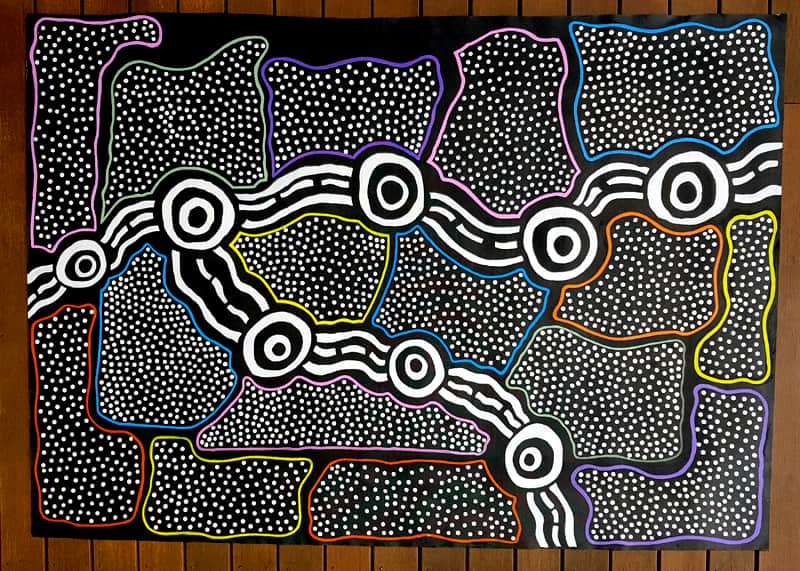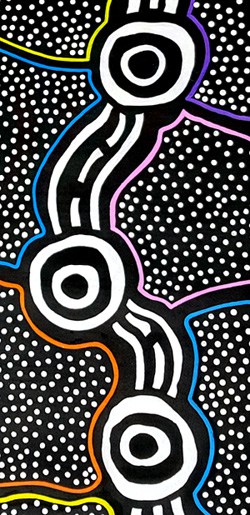Introduction
We would like to introduce and explain the story line that accompanies the ‘No Straight Lines: We all benefit from maps of life’s territories’ painting and video. Plus, share some symbols and reflective questions that can be useful when confronting and navigating challenges.
The ‘No Straight Lines’ painting was created following a conversation about how we all benefit from maps of life’s territories. Maps help us to identify and be aware of places, people and habits that are good for us, where we can draw sustenance and energy; as well as those places, people and habits that can impact negatively upon us.
Many of the people we live and work with have faced challenges and difficulties in their lives. Too often, these difficulties have been a result of abuse, hurt and betrayal by those in positions of responsibility (Including: sexual assault, domestic and family violence, removal from home, country and culture). This can leave us and our family, friends and colleagues struggling, feeling lost and uncertain which way to go.
Maps help ground and orient us. Where sometimes we can become stuck and overwhelmed by problems, spinning out of control; maps provide an overview that can help us find our way through difficult terrain. Maps help us to connect, share and draw upon the experience and knowledge of those who have come before.
“You have to know where the water is before you get thirsty”
‘The importance of developing and sharing maps of life’s territories was something I learnt as a young man growing up in the Northern Territory. I lived for a short time in a small Aboriginal community in remote eastern Arnhem Land, where we would be cut off each year for many weeks by wet season flooding.
One hot, humid and sunny tropical day, Senior Traditional Man, Grandfather Solomon, told us that we were going to Green Ant Dreaming. He shared with us that it was a long time since he had been there, so “we have to look for it, to find it little bit”.
Our small group of about seven, some senior men and some younger fellas like myself, travelled to the general area by four wheel drive, before setting off on foot along a small rise that lead up to the base of the escarpment. We were walking along a barely visible track, when Grandfather Solomon suddenly veered off course and lead us down toward a group of trees, just visible at the base of the rise, about sixty metres away.
We followed, as he was the person with the knowledge of country and he was one of the senior custodians for this area.
As we came closer to a group of paperbark trees, the air became a little cooler and you could hear the faint trickle of running water. Grandfather Solomon had brought us to a small oasis, about two metres across, fed by an underground spring that looked like it flowed from a catchment up on the escarpment.
We all drank, splashed ourselves with water, and then after short while, we moved off heading back toward the track up along the ridge in search of Green Ant Dreaming.
As we moved off, still relatively close in our group, Grandfather Solomon made it clear to us that:
“You have to know where the water is before you get thirsty. No good searching for somewhere to drink once you’re already thirsty. Panic can set in and you get lost and can die.”
This lesson, in the value of developing and sharing tracks and maps in order to navigate different and difficult terrain, is something I carry with me still.
— Anthony Newcastle.
No Straight Lines

The No Straight Lines painting acknowledges the value of shared learning. It makes use of recognisable symbols to share knowledge and understanding.
The circles represent water holes and places of rest and the lines in between, running water or tracks that connect one water hole or place of rest with another. Water holes can be meeting or gathering places where people can draw strength, sustenance and support for the next part of life’s journey.
The areas that contain dots, clumped together within coloured lines, represent different internal or external influences that can support or challenge us. Some areas of our life and community can engage us in thinking and actions that derail us, whilst alongside these exist places and people that offer support and encouragement.
As we live our lives, we learn to navigate these influences.
Developing your own map
Every person and community can benefit from developing maps of life’s territories.
Consider:
- Where do you draw strength and sustenance from?
- Where are good places for you to rest and replenish resources?
- Where is a place of safety and sanctuary for you?
- Where are the meeting places, points of connection for you?
- How do you know when a place or pathway is not good for you?
- What are signs of discomfort and distress?
- What resources and support will help you overcome difficulties?
- Who might assist you on this journey or part of a journey?
- Who supports and encourages you?
- Who or what activities bring good energy into your life?
- Who around you or in your community knows this terrain and can provide guidance?

Map making
We invite you to make use of the ‘No Straight Lines’ painting to help identify and name different patterns and influences in your life.
One area, say purple, may represent the influence of drink or violence on your life or community, with each dot or cluster symbolising people or events that can be either helpful or unhelpful when confronting this challenge.
Another area, say blue, may represent connections, music, food that bring you comfort and good memories or feelings. The dots or clusters symbolise those people or experiences related to this part of your life.
There are gaps between different areas, to remind us that we are not ‘locked in’, that there are ‘spaces in between’. Maps assist us to orient ourselves in the landscape, help us identify where we are and what is around us.
This is your map, so you get to name the different areas, people, events and accompanying emotions that influence your life. This is your journey, so you decide where you go next.
Creating and sharing maps are only part of the story
Maps do not tell us which way to go. They do not tell us who we are or who we can become. People, places and events can influence our life’s journeys, but do not dictate our futures. It can be useful, at times along life’s journeys, to pause and review, what is important to us and what are our values? It is useful to not only become aware of how we want to be in our lives and relationships, but to gather resources and to commit to becoming the person that we can rely on and we can be proud of.
Reflective questions
- What are your values?
- What is the code by which you wish to live your life?
- What are the elements of living a good life for you?
- How do you calm and relax yourself?
- How do you maintain your physical health?
- How do you express care?
- How do you enhance your relationships?
- How do you connect and support your community?
- How do you become the person you want to be?
- How do you know if you are on track?
- How do you keep yourself on track or get back on track?
- How do you encourage and support yourself?
Honouring and developing maps of community knowledge and connections
Developing Maps of Life’s Territories is about recognising and drawing upon individual and community resources and knowledge. When we are experiencing challenges, we often first try to resolve and navigate our way through using our own knowledge and resources. Typically, our next move is to seek guidance and support from those closest to us, from our partner, families and communities. Even when we do reach out to service providers and professionals, this does not take away the importance of continuing to collect, learn from and draw upon community resources and support. Creating and sharing community Maps of Life’s Territories is something all people can contribute to and benefit from.
No Straight Lines
We all benefit from maps of life’s territories.
People, places and events influence our journeys.
We do not live our lives in straight lines.
If we are fortunate, we meet people along the way who care, encourage and support us
and show us where we can feed and rest.
Even then, we can face abuse, hurt, isolation and struggle.
We can encounter challenges, hit road blocks and become uncertain which way to go.
It can be useful at times to pause, look at the bigger picture,
identify helpful and unhelpful patterns,
and gather with those who assist and guide us through life’s territories.
We do not live our lives in straight lines.
— Gary Foster and Anthony Newcastle
